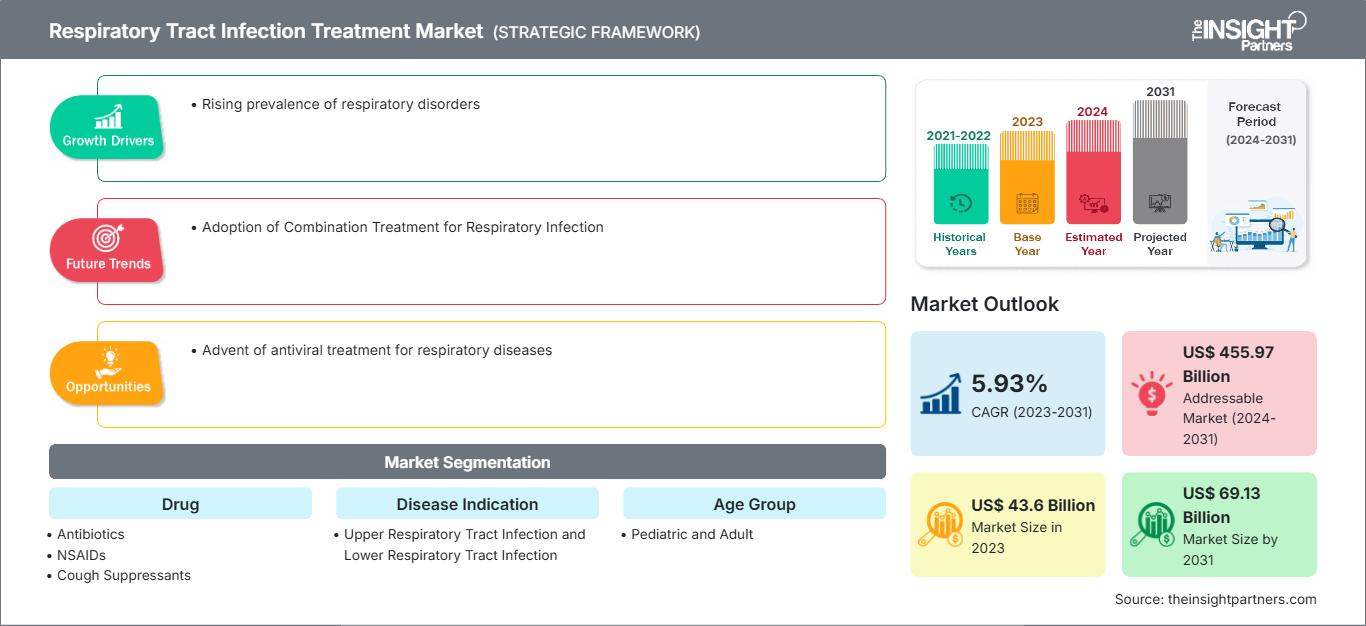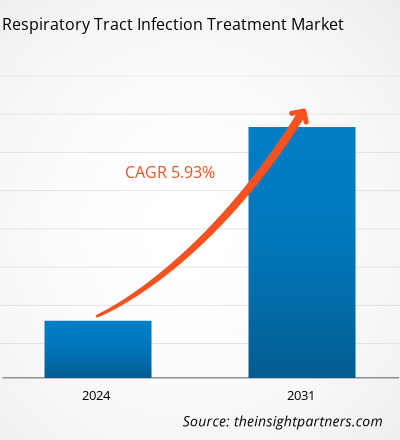Se prevé que el tamaño del mercado de tratamiento de infecciones del tracto respiratorio alcance los 69.130 millones de dólares estadounidenses en 2031, frente a los 43.600 millones de dólares estadounidenses en 2023; se anticipa que registre una tasa de crecimiento anual compuesta (TCAC) del 5,93% durante el período 2023-2031.
Las infecciones del tracto respiratorio (ITR) son infecciones de los senos paranasales, la garganta, las vías respiratorias o los pulmones. El informe sobre el mercado mundial de tratamientos para las ITR destaca los factores clave que impulsan el mercado y describe la evolución de los principales actores. Entre los factores clave que impulsan el crecimiento del mercado se incluyen la creciente prevalencia de las infecciones respiratorias a nivel mundial, la mayor concienciación sobre estas infecciones y las diversas terapias relacionadas, así como el creciente número de ensayos clínicos sobre su tratamiento. Sin embargo, la falta de investigación centrada en las terapias respiratorias y los efectos adversos de los fármacos para las infecciones respiratorias dificulta el crecimiento del mercado. Además, se espera que la aparición de tratamientos antivirales genere nuevas tendencias en el mercado mundial de tratamientos para las ITR en los próximos años.
Factores impulsores y restricciones del crecimiento:
Aumento de la demanda de diagnóstico de enfermedades respiratorias entre la población anciana
A medida que la población de edad avanzada crece a nivel mundial, se prevé que la demanda de diagnósticos de enfermedades respiratorias aumente en los próximos años. Por ejemplo, según un artículo publicado en el British Journal of Pharmacology en noviembre de 2021, aproximadamente el 1 % de la población del Reino Unido recibe un diagnóstico anual de neumonía adquirida en la comunidad (NAC). Alrededor del 70 % de los casos se presentan en personas mayores de 65 años, y la mortalidad a 30 días en este grupo etario es de aproximadamente el 20 %. Por lo tanto, se espera que el aumento de la población de edad avanzada y la mayor incidencia de enfermedades como la NAC impulsen la demanda de tratamientos para enfermedades respiratorias, lo que a su vez impulsará el crecimiento general del mercado.
La investigación y el desarrollo continuos en este campo han dado como resultado diversas pruebas y procedimientos diagnósticos que influirán positivamente en el crecimiento del mercado en los próximos años. Se prevé que los métodos diagnósticos innovadores ofrezcan buenas oportunidades para el desarrollo del mercado durante el período de pronóstico. Sin embargo, la escasez de estudios de investigación y las reacciones adversas relacionadas con los fármacos para las infecciones del tracto respiratorio podrían limitar el crecimiento del mercado mundial de tratamientos para estas infecciones.
Obtendrá personalización gratuita de cualquier informe, incluyendo partes de este informe, análisis a nivel de país y paquetes de datos de Excel. Además, podrá aprovechar excelentes ofertas y descuentos para empresas emergentes y universidades.
Mercado del tratamiento de infecciones del tracto respiratorio: Perspectivas estratégicas

-
Obtenga las principales tendencias clave del mercado de este informe.Esta muestra GRATUITA incluirá análisis de datos, que abarcarán desde tendencias de mercado hasta estimaciones y pronósticos.
Segmentación y alcance del informe:
El análisis del mercado global de tratamientos para infecciones respiratorias se ha realizado considerando los siguientes segmentos: indicación del fármaco, vía de administración, grupo de edad y canal de distribución. Según el fármaco, el mercado se divide en antibióticos, AINE, antitusivos, descongestionantes nasales y otros. Por indicación de la enfermedad, el mercado global de tratamientos para infecciones respiratorias se segmenta en infecciones de las vías respiratorias superiores e inferiores. En cuanto a la vía de administración, el mercado se divide en oral y parenteral. Según el grupo de edad, el mercado se clasifica en pediátrico y adulto. Según el canal de distribución, el mercado global de tratamientos para infecciones respiratorias se segmenta en farmacias hospitalarias, farmacias en línea y farmacias minoristas.
Análisis segmentario: Analysis:
En cuanto a fármacos, el segmento de antibióticos ostentó la mayor cuota de mercado mundial en el tratamiento de infecciones respiratorias en 2023. Se prevé que este segmento registre la mayor tasa de crecimiento anual compuesto (TCAC) durante el período 2023-2031. Las infecciones respiratorias abarcan diversas afecciones, como bronquitis, neumonía y sinusitis, a menudo causadas por bacterias patógenas. Los antibióticos actúan contra estas bacterias dañinas, eliminándolas, reduciendo la inflamación y favoreciendo una recuperación más rápida. Entre los antibióticos que se prescriben habitualmente para las infecciones respiratorias se incluyen las penicilinas, las cefalosporinas, los macrólidos, las fluoroquinolonas y las tetraciclinas; cada uno de ellos posee mecanismos de acción y dianas bacterianas específicos.
Según la indicación de la enfermedad, el segmento de infecciones de las vías respiratorias inferiores (IVRI) ostentó una mayor cuota de mercado en 2023. Se prevé que registre una tasa de crecimiento anual compuesto (TCAC) aún mayor entre 2023 y 2031. Las IVRI son infecciones que afectan a los pulmones y los bronquios, causadas generalmente por patógenos bacterianos, virales o fúngicos, entre otros. Afecciones como la neumonía, la bronquitis y la bronquiolitis, que suelen presentar síntomas como tos productiva, molestias en el pecho, dificultad para respirar y fiebre, se clasifican dentro del espectro de las IVRI. La neumonía, una IVRI grave, implica la inflamación e infección del tejido pulmonar, lo que conlleva consolidación pulmonar (en algunas zonas del pulmón o en todo el órgano) y alteración del intercambio gaseoso.
Por vía de administración, la oral representó la mayor parte del mercado mundial de tratamiento de infecciones respiratorias; se prevé que este segmento registre una mayor tasa de crecimiento anual compuesto (TCAC) entre 2023 y 2031. Los antibióticos orales, como la amoxicilina, la azitromicina o la doxiciclina, se prescriben con frecuencia para combatir los patógenos bacterianos que causan infecciones respiratorias. Además de los antibióticos, los corticosteroides orales pueden reducir la inflamación en casos de asma grave o exacerbaciones de la enfermedad pulmonar obstructiva crónica (EPOC). Los antivirales orales, como el oseltamivir, se utilizan para tratar infecciones respiratorias virales, como la gripe. Las ventajas comunes de la vía oral incluyen la facilidad de administración, la buena adherencia al tratamiento y la distribución sistémica del fármaco.
En cuanto a grupos de edad, el segmento de adultos representó la mayor parte del mercado mundial de tratamiento de infecciones respiratorias en 2023. Se prevé que el segmento pediátrico registre una mayor tasa de crecimiento anual compuesto (TCAC) durante el período 2023-2031. Factores como la mayor concienciación sobre la importancia del diagnóstico y tratamiento precoces de las infecciones respiratorias en niños y los avances en los dispositivos respiratorios utilizados para el tratamiento están impulsando el desarrollo de opciones terapéuticas nuevas y más eficaces. Además, el creciente interés por la atención sanitaria preventiva está contribuyendo al crecimiento del mercado pediátrico.
En cuanto al canal de distribución, se prevé que el segmento de farmacias hospitalarias represente una cuota de mercado significativa entre 2023 y 2031. Las farmacias hospitalarias son componentes clave del sistema sanitario; en particular, desempeñan un papel fundamental en el tratamiento de las infecciones respiratorias agudas y graves, que requieren la administración intravenosa o intramuscular de medicamentos. Estas farmacias se encargan de la adquisición, el almacenamiento y la dispensación de antibióticos, antivirales, corticosteroides y otros tratamientos para infecciones respiratorias, así como de garantizar su entrega segura y oportuna a pacientes hospitalizados y ambulatorios.
Perspectivas regionales del mercado de tratamientos para infecciones del tracto respiratorio
Los analistas de The Insight Partners han explicado en detalle las tendencias y los factores regionales que influyen en el mercado de tratamientos para infecciones respiratorias durante el período de previsión. Esta sección también analiza los segmentos y la geografía del mercado de tratamientos para infecciones respiratorias en Norteamérica, Europa, Asia Pacífico, Oriente Medio y África, y Sudamérica y Centroamérica.
Alcance del informe de mercado sobre el tratamiento de infecciones del tracto respiratorio
| Atributo del informe | Detalles |
|---|---|
| Tamaño del mercado en 2023 | 43.600 millones de dólares estadounidenses |
| Tamaño del mercado en 2031 | 69.130 millones de dólares estadounidenses |
| CAGR global (2023-2031) | 5,93% |
| Datos históricos | 2021-2022 |
| período de previsión | 2024-2031 |
| Segmentos cubiertos |
Por drogas
|
| Regiones y países cubiertos |
América del norte
|
| Líderes del mercado y perfiles de empresas clave |
|
Densidad de los participantes en el mercado del tratamiento de infecciones del tracto respiratorio: comprensión de su impacto en la dinámica empresarial
El mercado de tratamientos para infecciones respiratorias está creciendo rápidamente, impulsado por la creciente demanda de los usuarios finales debido a factores como la evolución de las preferencias de los consumidores, los avances tecnológicos y una mayor conciencia de los beneficios del producto. A medida que aumenta la demanda, las empresas amplían su oferta, innovan para satisfacer las necesidades de los consumidores y aprovechan las nuevas tendencias, lo que impulsa aún más el crecimiento del mercado.

- Obtenga una visión general de los principales actores del mercado de tratamientos para infecciones del tracto respiratorio.
Análisis regional:
La creciente concienciación de la población sobre la importancia del diagnóstico y tratamiento precoces de las infecciones respiratorias probablemente contribuirá al crecimiento del mercado mundial de tratamientos para infecciones respiratorias en los próximos años. El mercado se segmenta en Norteamérica, Europa, Asia-Pacífico, Oriente Medio y África, y Sudamérica y Centroamérica. Norteamérica ostentó la mayor cuota de mercado mundial de tratamientos para infecciones respiratorias en 2023. El mercado norteamericano está experimentando un crecimiento significativo debido a la elevada prevalencia de estas infecciones en el país. Factores como la contaminación atmosférica, el tabaquismo y el hacinamiento contribuyen a la alta incidencia de infecciones respiratorias en Norteamérica. El aumento de la prevalencia de infecciones respiratorias, una mayor concienciación sobre la salud y las iniciativas gubernamentales favorables impulsan el crecimiento del mercado mundial de tratamientos para infecciones respiratorias.
Panorama competitivo y empresas clave:
El pronóstico del mercado mundial de tratamientos para infecciones respiratorias puede ayudar a las partes interesadas a planificar sus estrategias de crecimiento. Abbott Laboratories, AstraZeneca plc, Alembic Pharmaceuticals Ltd., Boehringer Ingelheim International GmbH, GlaxoSmithKline plc, Teva Pharmaceutical Industries Ltd, Novartis AG, F. Hoffmann-La Roche AG, Sanofi SA, Merck & Co. y Cipla se encuentran entre los principales actores analizados en el informe del mercado mundial de tratamientos para infecciones respiratorias. Estas empresas se centran en diversas estrategias (tanto orgánicas como inorgánicas) para satisfacer la creciente demanda de los consumidores y ampliar su gama de productos en áreas especializadas. Las principales estrategias adoptadas por las empresas en el mercado incluyen el lanzamiento de nuevas tecnologías, el desarrollo de productos existentes y la expansión geográfica.
- Análisis histórico (2 años), año base, pronóstico (7 años) con CAGR
- Análisis PEST y FODA
- Tamaño del mercado, valor/volumen: global, regional y nacional
- Industria y panorama competitivo
- Conjunto de datos de Excel
Informes recientes
Testimonios
Razón para comprar
- Toma de decisiones informada
- Comprensión de la dinámica del mercado
- Análisis competitivo
- Información sobre clientes
- Pronósticos del mercado
- Mitigación de riesgos
- Planificación estratégica
- Justificación de la inversión
- Identificación de mercados emergentes
- Mejora de las estrategias de marketing
- Impulso de la eficiencia operativa
- Alineación con las tendencias regulatorias






















 Obtenga una muestra gratuita para - Mercado de tratamiento de infecciones del tracto respiratorio
Obtenga una muestra gratuita para - Mercado de tratamiento de infecciones del tracto respiratorio